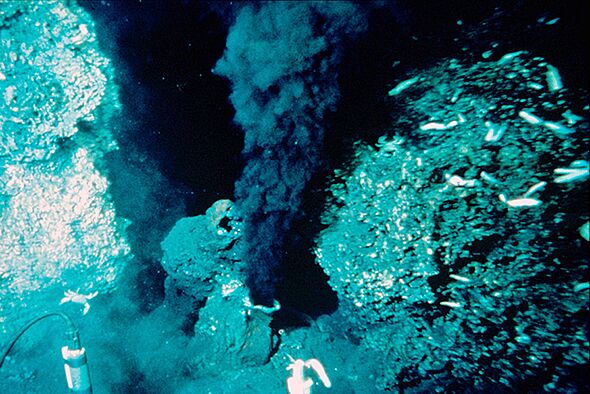East Pacific Rise facts for kids

The East Pacific Rise (EPR) is a mid-ocean rise (usually termed an oceanic rise and not a mid-ocean ridge due to its higher rate of spreading that results in less elevation increase and more regular terrain), at a divergent tectonic plate boundary, located along the floor of the Pacific Ocean. It separates the Pacific Plate to the west from (north to south) the North American Plate, the Rivera Plate, the Cocos Plate, the Nazca Plate, and the Antarctic Plate. It runs south from the Gulf of California in the Salton Sea basin in Southern California to a point near 55°S 130°W / 55°S 130°W, where it joins the Pacific-Antarctic Ridge (PAR) trending west-south-west towards Antarctica, near New Zealand (though in some uses the PAR is regarded as the southern section of the EPR). Much of the rise lies about 3,200 km (2,000 mi) off the South American coast and reaches a height about 1,800–2,700 m (5,900–8,900 ft) above the surrounding seafloor.
Overview

The oceanic crust is moving away from the East Pacific Rise to either side. Near Easter Island the rate is over 150 mm (6 in) per year which is the fastest in the world. However, on the northern end, it is much slower at only roughly 60 mm (2+1⁄2 in) per year. On the eastern side of the rise, the eastward-moving Cocos and Nazca plates meet the westward moving South American Plate and the North American Plate and are being subducted under them. The belt of volcanos along the Andes and the arc of volcanoes through Central America and Mexico are the direct results of this collision. Due east of the Baja California Peninsula, the Rise is sometimes referred to as the Gulf of California Rift Zone. In this area, newly formed oceanic crust is intermingled with rifted continental crust originating from the North American Plate.
Near Easter Island, the East Pacific Rise meets the Chile Rise at the Easter Island and Juan Fernandez microplates, trending off to the east where it subducts under the South American Plate at the Peru–Chile Trench along the coast of southern Chile. This portion of the Rise has been referred to as the Cape Adare-Easter Island Ridge, Albatross Cordillera, Easter Island Cordillera, Easter Island Rise, and Easter Island Swell.
Parts of the East Pacific Rise have oblique spreading, such as the Nazca–Pacific plate boundary between 29°S and 32°S. This is seafloor spreading that is not orthogonal to the nearest ridge segment.
The southern extension of the East Pacific Rise (the PAR) merges with the Southeast Indian Ridge at the Macquarie Triple Junction south of New Zealand. The southern stretch of the East Pacific Rise is also one of the fastest-spreading divergent boundaries on Earth, peaking at 79.3 mm (3.12 in)/year.
Along the East Pacific Rise the hydrothermal vents called black smokers were first discovered by the RISE project in 1979, and have since been extensively studied. These vents are forming volcanogenic massive sulfide ore deposits on the ocean floor. Many unique deep-water creatures have been found with vents, that subsist in a chemosynthetic ecosystem rather than one using photosynthesis.
See also
 In Spanish: Dorsal del Pacífico Oriental para niños
In Spanish: Dorsal del Pacífico Oriental para niños
- Pacific-Antarctic Ridge
- Lamont seamount chain
- Mid-Atlantic Ridge
- Overlapping spreading centers
- Propagating rift
- Ring of Fire

